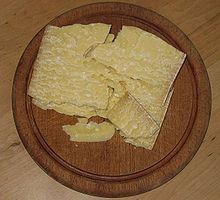Sbrinz
Sbrinz (also known as Spalenkäse until the early 20th century ) is a hard cheese or extra- hard cheese from central Switzerland , one of the oldest cheeses in Europe. It is mainly made by hand in copper kettles in the cantons of Lucerne , Obwalden and Nidwalden using traditional methods.
ingredients
Apart from raw milk , rennet , cultures and salt, Sbrinz does not contain any other ingredients or additives. Since it is very dry, it has a good shelf life. Its salt content is 12 to 16 g / kg. For comparison: Emmentaler has a salt content of 5 g / kg.
Distribution area
Most of the Sbrinz is consumed in Switzerland itself. A large part of the production has been exported to northern Italy for centuries . The path from Lake Lucerne over the Brünig and Grimsel passes was known as the Sbrinz route . Large quantities of Sbrinz were also exported via the Gotthard Pass and then traded in Magadino . At times, one to two fifths of the goods cleared by customs in Ursern were Sbrinz cheese. In Germany and Austria, however, Sbrinz is little known and not available everywhere.
character
Sbrinz has a characteristic, spicy, intense cheese taste. Due to the long storage period, its consistency is waxy, brittle and somewhat crystalline. It is stored for at least 16 months before it goes on sale. Before it is on the table, it should be at least two years old, or even better three years old. Five-year-old Sbrinz tastes even more pronounced, stronger and spicier.
Sbrinz can be found in the kitchen in various dosage forms: as a sliced roll, as Möckli (chunks) or as grated cheese. Sbrinz is an excellent grated cheese for pasta dishes , especially as an alternative to Parmesan . It is also suitable as a companion to bread and a strong, dry white wine . Traditionally, it is not cut, but broken. There is the so-called Sbrinz engraver for this purpose.
Name designation
The name of the cheese is believed to be of Romanesque origin and can be associated with the Romanian word brinza and the Dalmatian brenza (a type of sheep cheese). The city of Brienz , which was the main trading point for Sbrinz in the Middle Ages, is also considered to be the eponym. Many Swiss people still pronounce the name in two syllables ( lettering - with emphasis on the "i"). The former name Spalenkäse refers to the geküferten wooden barrels in which the Säumergesellschaften cheese transported over the passes.
The name is a protected designation of origin and therefore has the addition of AOC . Sbrinz Käse GmbH currently has 30 production companies. In 2012, 1940 tons of Sbrinz were produced, the stock was just over 3000 tons.
literature
- Luzerner Tagblatt from September 15, 1954, special issue for the Swiss Agricultural Exhibition (SLA), article by Oskar Burri.
Web links
- Sbrinz in the database of Culinary Heritage of Switzerland
- Agroscope : agroscope.admin.ch: Sbrinz AOC
- aop-igp.ch : Swiss Association of AOP-IGP
- sbrinz.ch: Website of Sbrinz Cheese GmbH
- sbrinz-route.ch
Individual evidence
- ↑ Käser - Discussion Groups, Sbrinz, 2001, External Investigations (PDF) ( Memento of the original from March 23, 2016 in the Internet Archive ) Info: The archive link was inserted automatically and has not yet been checked. Please check the original and archive link according to the instructions and then remove this notice. , Eidgenössische Forschungsanstalt für Milchwirtschaft, p. 9, accessed on March 17, 2016
- ↑ Emmentaler range , on the Emmentaler Switzerland website, accessed on March 17, 2016
- ^ Sbrinz in the database of Culinary Heritage of Switzerland
- ^ Sbrinz Käse GmbH: Our cheese factories
- ↑ Sbrinz Käse GmbH: Annual Report 2013, p. 10 ( PDF download )

